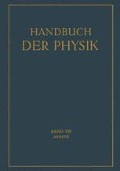Zusammenfassung
Akustische Vorgänge, d. h. solche, die durch das Gehörorgan zu unserer Wahrnehmung gelangen, lassen sich stets auf Schwingungen von irgendwelchen Körpern zurückführen. So entsteht z. B. ein Klang durch die Schwingungen eines Körpers, einer gespannten Saite, einer Stimmgabel oder dgl. Die Luft überträgt den Schall, indem ihre einzelnen Teilchen Schwingungen um eine bestimmte Ruhelage ausführen.
Access this chapter
Tax calculation will be finalised at checkout
Purchases are for personal use only
Preview
Unable to display preview. Download preview PDF.
References
Lord Rayleigh, Theory of Sound I., 2. Aufl., §42a. London 1894; s. auch Phil. Mag. (6) Bd. 37, S. 321. 1918.
E. Waetzmann, Die Resonanztheorie des Hörens, S. 133 ff. Braunschweig 1912.
C. Stumpf, ZS. f. Psychol. u. Physiol, d. Sinnesorg. Bd. 39, S. 241. 1905.
Die hier angegebene elementare Ableitung genügt allerdings nicht zur strengen Erklärung der Wahrnehmung von Schwebungstönen durch das menschliche Ohr. Vgl. hierzu im einzelnen den Artikel „Das Gehör“, Ziff. 25 ff. (ds. Bd. Kap. 11).
Siehe z. B. R. König, Pogg. Ann. Bd. 157, S. 177. 1876.
F.A. Schulze, Ann. d. Phys. Bd. 26, S. 217. 1908.
H. v. Helmholtz, Die Lehre von den Tonempfindungen, 6. Aufl, S. 287. Braunschweig 1913.
K. L. Schaefer u. O. Abraham, Ann. d. Phys. Bd. 13, S. 996. 1904.
R. König, Pogg. Ann. Bd. 157, S. 177. 1876.
L. Hermann, Pflügers Arch. f. d. ges. Physiol. Bd. 47, S. 347. 1890.
L. Hermann, Pflügers Arch. f. d. ges. Physiol. Bd. 56, S. 449. 1894; Bd. 146, S. 285. 1912.
F.A. Schulze, Ann. d. Phys. Bd. 45, S. 283. 1915.
Siehe z. B. R. Courant u. D. Hilbert, Methoden der mathematischen Physik Bd. I, S. 46 ff. Berlin 1924,; K. KNOPP, Theorie und Anwendung der unendlichen Reihen, S. 351 ff. Berlin 1924; RIEMANN-WEBER, Die Differential-und Integralgleichungen der Mechanik und Physik Bd. T, S. 157ff. Braunschweig 1925.
G. S. Ohm, Fogg. Ann. Bd. 59, S. 497. 1843.
H. v. Helmholtz, Die Lehre von den Tonenipfindungen, 6. Ausg., S. 39. Braunschweig 1913.
H. v. Helmholtz, Die Lehre von den Tonempfindungen, 6. Ausg., S. 203 ff.Braunschweig 1913.
F. Lindig, Ann. d. Phys. Bd. 10, S. 242. 1903; M. G. LLOYD u. P. G. AGNEW, Bull. Bureau of Stand. Bd. 6, S. 255. 1909. Vgl. hierzu auch Artikel „Musikinstrumente und ihre Klänge“, Ziff. 11, ds. Bd. Kap. 8, und Artikel „Das Gehör“, Ziff. 39 ds. Bd. Kap 11.
Gibbs, Nature Bd. 59, S. 606. 1898; vgl. aber auch WILBRAHAM, Cambr. a. Dubl. Math. Journ. Bd. 3. 1848.
F. Trendelenburg, Wiss. Veröffentl. a. d. Siemens-Konzern Bd. IV, 1, S. 1. 1925.
S. aber hierzu: A. Kalähne, Grundzüge der math.-phys. Akustik Bd. I, S. 20–25. Leipzig u. Berlin 1910.
Über Feststellung und Ausgleich von Fehlern bei rechnerischen Methoden zur Fourieranalyse s. W. Mason, Phys. Rev. Bd. 27, S. 315. 1913.
O. Krigar-Menzel, Wied. Ann. Bd. 49, S. 545. 1893.
H. Philips, ZS. i Sinnesphysiol. Bd. 57, S. 305. 1926.
C. Runge u. F. Emde, Rechnungsformular zur Zerlegung einer empirisch gegebenen periodischen Funktion in Sinuswellen. Braunschweig 1913; s. auch H. v. SANDEN, Prakt. Analysis, S. 124ff. Leipzig u. Berlin 1914.
F. F. Martens, Verh. d. D. Phys. Ges. Bd. 14, S. 983. 1912.
L. Hermann, Pflügers Arch. f. d. ges. Physiol. Bd. 47, S. 45. 1890.
L. Zipperer, Dinglers Journ. Bd. 333, S. 201. 1918. Derselbe, Tafeln zur harmonischen Analyse. Berlin 1922.
F. F. Martens, Verh. d. D. Phys. Ges. Bd. 11, S. 63. 1909.
L. Hermann, Pflügers Arch. f. d. ges. Physiol. Bd. 47, S. 45. 1890; vgl. auch J. LINDELöFF, Ebenda Bd. 85, S. 59. 1901 u. Bd. 87, S. 597. 1901.
L. W. Pollack, Rechentafeln zur harmonischen Analyse. Leipzig 1926.
J. Lahr, Wied. Ann. Bd. 27, S. 108. 1886.
K. Pichelmayer u. L. V. Schrutka, Elektrot. ZS. 1912, S. 129; F. MEURER, ebenda 1913, S. 121; s. auch W. HORT, Technische Schwingungslehre, S. 141-146. Berlin 1922. 2) Siehe H. v. SANDEN, Prakt. Analysis, S. 121. Leipzig u. Berlin 1914.
E. Orlich, Aufnahme und Analyse von Wechselstromkurven. Braunschweig 1916; A. GALLE, Mathematische Instrumente, S. 131. Leipzig 1912.
A. Sommerfeld u. E. Wiechert, Schriften d. Königsb. Ges. Bd. 32, S. 28. 1891; s. auch A. GALLE, a. a. O. S. 145ff.
O. Henrici, Phil. Mag. Bd. 38, S. 113. 1894; G. CORADI, Der harmonische Analysator. Zürich 1894; s. auch W. HORT, Technische Schwingungslehre, S. 149ff. Berlin 1922.
E. Lübcke, Phys. ZS. Bd. 16, S. 453. 1915.
O. Mader, Elektrot. ZS. 1909, S. 847.
H. Riegger, Wiss. Veröffentl. a. d. Siemens-Konz. Bd. 3, 1, S. 190. 1923.
J. Lissajous, Ann. chim. phys. Bd. 51, S. 147. 1857; s. auch H. v. HELMHOLTZ, Lehre von den Tonempfindungen, 6. Ausg., S. 138. Braunschweig 1913.
J. Lissajous, Ann. de chim. phys. Bd. 51, S. 147. 1857.
F. Melde, Die Lehre von den Schwingungskurven, S. 36. Leipzig 1864.
F. Melde, Die Lehre von den Schwingungskurven. Leipzig 1864.
G. Zambiasi, Le figure di Lissajous. Torino 1903.
W. Braun, Inaug.-Diss. Erlangen 1875.
Himstedt, Arch. d. Math. u. Phys. Bd. 70, S. 337. 1884.
H. Ekama, Arch. d. Math. u. Phys. Bd. 50, S. 39. 1888.
Author information
Authors and Affiliations
Editor information
Additional information
Besonderer Hinweis
Dieses Kapitel ist Teil des Digitalisierungsprojekts Springer Book Archives mit Publikationen, die seit den Anfängen des Verlags von 1842 erschienen sind. Der Verlag stellt mit diesem Archiv Quellen für die historische wie auch die disziplingeschichtliche Forschung zur Verfügung, die jeweils im historischen Kontext betrachtet werden müssen. Dieses Kapitel ist aus einem Buch, das in der Zeit vor 1945 erschienen ist und wird daher in seiner zeittypischen politisch-ideologischen Ausrichtung vom Verlag nicht beworben.
Rights and permissions
Copyright information
© 1927 Julius Springer in Berlin
About this chapter
Cite this chapter
Backhaus, H. (1927). Elementare Schwingungslehre. In: Backhaus, H., et al. Akustik. Handbuch der Physik, vol 8. Springer, Berlin, Heidelberg. https://doi.org/10.1007/978-3-642-47352-4_2
Download citation
DOI: https://doi.org/10.1007/978-3-642-47352-4_2
Publisher Name: Springer, Berlin, Heidelberg
Print ISBN: 978-3-642-47105-6
Online ISBN: 978-3-642-47352-4
eBook Packages: Springer Book Archive

